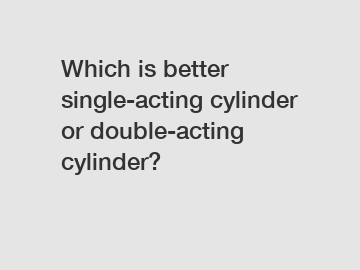Feb. 05, 2024
Machinery
Hydraulic cylinders are essential components used in a wide range of industrial applications, allowing linear motion and power transmission. With two main types available in the market, the choice between a single-acting and double-acting cylinder can significantly impact the performance and efficiency of hydraulic systems. In this blog, we will dive into the comparisons and contrasts between these two cylinder types, their functionalities, and when to choose one over the other.
Understanding Single-Acting Cylinders:
A single-acting cylinder is a hydraulic actuator that primarily operates in one direction. It converts fluid pressure into linear mechanical force by utilizing hydraulic fluid entering through a port in one direction to extend the cylinder. The return stroke is achieved by using external forces such as gravity or springs. Single-acting cylinders are commonly used in applications where force is required in only one direction, like in dump trucks, drilling machines, or hydraulic presses.

Pros of Single-Acting Cylinders:
1. Cost-effective: Since single-acting cylinders use fewer components, they tend to be more economical, making them a popular choice for budget-conscious projects.
2. Simplicity: The design simplicity of single-acting cylinders reduces the chances of mechanical failures, making them reliable in various industrial environments.
3. Energy-efficient: As fluid pressure is required only during extension, single-acting cylinders consume less hydraulic power than their double-acting counterparts.
Exploring Double-Acting Cylinders:
Double-acting cylinders are the workhorses of hydraulic systems. They utilize hydraulic fluid pressure in both directions to generate motion. These cylinders consist of two ports: one for extending the cylinder and the other for retracting it. By controlling the flow of fluid, double-acting cylinders can provide both push and pull forces. They find applications in heavy-duty machinery, robotics, construction equipment, and more.
Advantages of Double-Acting Cylinders:
1. Versatility: Double-acting cylinders offer bidirectional force, providing greater flexibility and control in applications that require both extension and retraction forces.
2. Increased Power: Utilizing hydraulic pressure in both directions, double-acting cylinders provide higher force capabilities, making them suitable for heavy-duty tasks and lifting operations.
3. Balanced Performance: The ability to control both extension and retraction allows for precise and controlled movements, ultimately enhancing the overall operational efficiency.
Choosing the Right Cylinder for Your Needs:
The choice between single-acting and double-acting cylinders depends on several factors:
1. Application: Determine whether your application requires unidirectional or bidirectional force. If you need force in one direction only, a single-acting cylinder is a cost-effective choice. If you require full control over both extension and retraction, a double-acting cylinder is recommended.
2. Load Conditions: Evaluate the load requirements of your application. If you need consistent force in both directions, a double-acting cylinder will provide optimal performance. Single-acting cylinders may be suitable for situations where the reverse force can be achieved by external means.
3. Cost Considerations: Budget and monetary constraints play an important role in decision-making. Single-acting cylinders offer a more affordable solution, while double-acting cylinders provide superior capabilities with slightly higher costs.
Conclusion:
Selecting the appropriate hydraulic cylinder for your specific application is crucial for optimum performance and efficiency. Both single-acting and double-acting cylinders have their advantages, and understanding their key distinctions is vital to making an informed choice. Double-acting cylinders offer versatility, power, and precision, making them a preferred option for demanding applications. On the other hand, single-acting cylinders provide simplicity, cost-effectiveness, and efficiency in situations where unidirectional force is sufficient.
Ultimately, the choice between a single-acting and double-acting cylinder relies on a thorough assessment of your project requirements, load conditions, and cost factors. By considering these aspects, you can make a well-informed decision, ensuring optimal performance and long-term reliability for your hydraulic system.
If you are looking for more details, kindly visit die casting hydraulic cylinders in steel mills, Metallurgical Custom Hydraulic Cylinder Supplier, customized stainless steel hydraulic cylinder manufacturer.
Previous: Which Auto Feeding Manual Screwdriver Offers the Best Performance?
Next: Durable Coil Straightening Machine: Your Solution to Straighten Coils with Efficiency!
If you are interested in sending in a Guest Blogger Submission,welcome to write for us!
All Comments ( 0 )